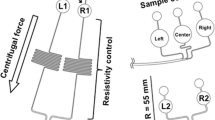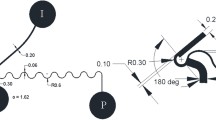Abstract
This paper reports a miniature microfluidic system based on centrifugal and gravity actuations for separation of blood cells. The fluidic platform is driven with a motor and controlled using a single-chip micyoco (SCM). Centrifugal force was used both for delivering the blood sample and realizing density gradient centrifugation for separation of red blood cells from plasma. By utilizing the centrifugal force, Coriolis force, Euler’s force, and gravity force in actuation of blood sample, a compact design of three-dimensional fluidic system for flow control was achieved. The centrifugal microfluidic platform was fabricated using 3D printing technology with polymers as structural materials. Because of the strong adhesion of leukocyte and the larger sizes of the blood cells, silica electrospun fiber was used as filter for white cells. In the experiments, the average removal rate of red blood cells is controllable by changing the working parameters. The instrument can separate 20–50 μl plasma at a time. No white cells were found in the plasma after separation.





Similar content being viewed by others
References
Akagi T, Ichiki T (2008) Cell electrophoresis on a chip: what can we know from the changes in electrophoretic mobility? Anal Bioanal Chem 391(7):2433–2441. https://doi.org/10.1007/s00216-008-2203-9
Andersson H, Den Berg AV (2003) Microfluidic devices for cellomics: a review. Sens Actu B Chem 92(3):315–325
Bhagat AAS, Bow H, Hou HW et al (2010) Microfluidics for cell separation. Med Biol Eng Comput 48(10):999–1014. https://doi.org/10.1007/s11517-010-0611-4
Bhagat AA, Hou HW, Li LD et al (2011) Pinched flow coupled shear-modulated inertial microfluidics for high-throughput rare blood cell separation. J Lab A Chip 11(11):1870
Chen X et al (2008) “Microfluidic chip for blood cell separation and collection based on crossflow filtration”. Sens Actu B Chem 5:216–221
Chen X, Chen H, Dezhi Wu et al (2018) 3D printed microfluidic chip for multiple anticancer drug combinations. Sens Actu B Chem 276:507–516
Davies CN (1973) Air Filtration. Academic Press, London
Dow P, Kotz KT, Gruszka S et al (2018) Acoustic separation in plastic microfluidics for rapid detection of bacteria in blood using engineered bacteriophage. Lab Chip 18(6):923–932. https://doi.org/10.1039/c7lc01180f
Fu YA, Spence C, Scherer A et al (1999) A microfabricated fluorescence-activated cell sorter. J Nat Biotechnol 17(11):1109–1111. https://doi.org/10.1038/15095
Geng Z, Yanrui Ju, Wang W, Li Z (2013) Continuous blood separation utilizing spiral filtration microchannel with gradually varied width and micro-pillar array. Sens Actu B Chem 180:122–129
Guo S, Ke Q, Wang H et al (2013) Poly(butylene terephthalate) electrospun/melt-blown composite mats for white blood cell filtration. J Appl Poly Sci 128(6):3652–3659
Hampson SM, Rowe W, Christie SDR, Platt M (2018) 3D printed microfluidic device with integrated optical sensing for particle analysis. Sens Actu B Chem 256:1030–1037
He Y, Gao Q, Wu W et al (2016) 3D printed paper-based microfluidic analytical devices. Micromachines 7(7):108
Kim B, You D, Kim Y-J, Insung Oh, Choi S (2018) Motorized smart pipette for handheld operation of a microfluidic blood plasma separator. Sens Actu B Chem 267:581–588
Kobayashi T, Konishi S (2011) Microfluidic chip with serially connected filters for improvement of collection efficiency in blood plasma separation. Sens Actu B Chem 161(1):1176–1183
Kuo JN, Lin BY (2018) Microfluidic blood-plasma separation chip using channel size filtration effect. Microsyst Technol 24(4):2063–2070
Lee MG, Shin JH, Choi S, Park J-K (2014) Enhanced blood plasma separation by modulation of inertial lift force. Sens Actu B Chem 190:311–317
Liu C-H, Chen C-A, Chen S-J et al (2019) Blood plasma separation using a fidget-spinner. Anal Chem 91(2):1247–1253
Nagrath S, Sequist LV, Maheswaran S et al (2011) Isolation of rare circulating tumour cells in cancer patients by microchip technology. J Nature 10:120–260
Petersson F, Aberg L, Swärd-Nilsson AM et al (2007) Free flow acoustophoresis: microfluidic-based mode of particle and cell separation. J An Chem 79(14):5117–5123
Qu BY, Wu ZY, Fang F et al (2008) A glass microfluidic chip for continuous blood cell sorting by a magnetic gradient without labeling. Anal Bioanal Chem 392(7–8):1317–1324
Shen S, Zhang F, Wang S et al (2019) Ultra-low aspect ratio spiral microchannel with ordered micro-bars for flow-rate insensitive blood plasma extraction. Sens Actu B Chem 287:320–328
Song Y, Cheng D, Zhao L (2018) Microfluidics: fundamental, devices and applications: fundamentals and applications. Wiley, London (ISBN: 9783527341061)
Songjaroen T, Dungchai W, Chailapakul O et al (2012) Blood separation on microfluidic paper-based analytical devices. J Lab A Chip 12(18):3392–3398
Toner M, Irimia D (2005) Blood-on-a-chip. J Ann Rev Biomed Eng 7(7):77–103. https://doi.org/10.1146/annurev.bioeng.7.011205.135108
Wang MM, Tu E, Raymond DE et al (2005) Microfluidic sorting of mammalian cells by optical force switching. Nat Biotechnol 23(1):83–87
Wang L, Kropinski MC, Li PC (2011) Analysis and modeling of flow in rotating spiral microchannels: towards math-aided design of microfluidic systems using centrifugal pumping. J Lab on A Chip 11(12):2097–2108
Xia N, Hunt TP, Mayers BT et al (2006) Combined microfluidic-micromagnetic separation of living cells in continuous flow. Biomed Microdevice 8(4):299–308
Author information
Authors and Affiliations
Corresponding author
Additional information
Publisher's Note
Springer Nature remains neutral with regard to jurisdictional claims in published maps and institutional affiliations.
Rights and permissions
About this article
Cite this article
Qin, X., Chen, H., Jia, S. et al. A 3D printed three-dimensional centrifugal fluidic system for blood separation. Microsyst Technol 27, 2639–2646 (2021). https://doi.org/10.1007/s00542-020-05012-3
Received:
Accepted:
Published:
Issue Date:
DOI: https://doi.org/10.1007/s00542-020-05012-3




